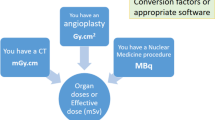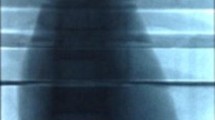Abstract
Purpose
To identify the relationship between fluoroscopy pulse rate and absorbed radiation dose. We compared absorbed radiation dose with common proxy measurements such as fluoroscopy time and C-arm reported dose.
Methods
Using a simulated patient model, 60 s fluoroscopy exposures were performed using pulse rates of 30, 8, 4, 2, and 1 pulse(s) per second. Each experiment was performed with both standard and low-dose settings using a GE OEC 9800 plus C-arm. Landauer nanoDot™ OSL dosimeters were used to measure the absorbed radiation dose.
Results
Fluoroscopy pulse rate and absorbed radiation dose demonstrated a linear correlation for both standard (R2 = 0.995, p < 0.001) and low-dose (R2 = 0.998, p < 0.001) settings. For any given pulse rate, using the low-dose setting reduced absorbed radiation dose by 58 ± 2.8%. Fluoroscopy time demonstrated a linear relationship with absorbed radiation dose for both standard (R2 = 0.996, p < 0.001) and low-dose (R2 = 0.991, p < 0.001) settings, but did not change with use of the low-dose setting. C-arm reported radiation dose correlated linearly with absorbed dose (R2 = 0.999) but consistently under-estimated measured values by an average of 49 ± 3.5%. Using a combination of 1 pulse-per-second and low-dose fluoroscopy, absorbed dose was reduced by 97.7 ± 0.1% compared to standard dose and 30 pulse-per-second settings.
Conclusion
Absorbed radiation dose decreases linearly with fluoroscopy pulse rate during equivalent exposure times. Adjusting fluoroscopy pulse rate and utilizing low-dose settings significantly reduces overall absorbed radiation exposure by up to 98%.



Similar content being viewed by others
Data availability
The data underlying this study are available from the corresponding author upon reasonable request.
References
Canales BK, Sinclair L, Kang D, Mench AM, Arreola M, Bird VG (2016) Changing default fluoroscopy equipment settings decreases entrance skin dose in patients. J Urol 195(4, Part 1):992–997
Elkoushy MA, Shahrour W, Andonian S (2012) Pulsed fluoroscopy in ureteroscopy and percutaneous nephrolithotomy. Urology 79(6):1230–1235
Yecies TS, Fombona A, Semins MJ (2017) Single pulse-per-second setting reduces fluoroscopy time during ureteroscopy. Urology 103:63–67
Smith DL, Heldt JP, Richards GD, Agarwal G, Brisbane WG, Chen CJ et al (2013) Radiation exposure during continuous and pulsed fluoroscopy. J Endourol 27(3):384–388
Mahesh M (2001) Fluoroscopy: patient radiation exposure issues. Radiographics 21(4):1033–1045
Council NR(2006) Health risks from exposure to low levels of ionizing radiation: BEIR VII phase 2
Ferrandino MN, Bagrodia A, Pierre SA, Scales CD, Rampersaud E, Pearle MS et al (2009) Radiation exposure in the acute and short-term management of urolithiasis at 2 academic centers. J Urol 181(2):668–673
Dudley AG, Semins MJ (2015) Radiation practice patterns and exposure in the high-volume endourologist. Urology 85(5):1019–1024
Kotre CJ, Charlton S, Robson KJ, Birch IP, Willis SP, Thornley M (2004) Application of low dose rate pulsed fluoroscopy in cardiac pacing and electrophysiology: patient dose and image quality implications. Br J Radiol 77(919):597–599
Sabat S, Slonimsky E (2018) Radiation reduction in low dose pulsed fluoroscopy versus standard dose continuous fluoroscopy during fluoroscopically-guided lumbar punctures: a prospective controlled study. J Clin Imaging Sci. 8:9
Durutovic O, Dzamic Z, Milojevic B, Nikic P, Mimic A, Bumbasirevic U et al (2016) Pulsed versus continuous mode fluoroscopy during PCNL: safety and effectiveness comparison in a case series study. Urolithiasis 44(6):565–570
Boland GWL, Murphy B, Arellano R, Niklason L, Mueller PR (2000) Dose reduction in gastrointestinal and genitourinary fluoroscopy. Am J Roentgenol 175(5):1453–1457
Ward VL, Barnewolt CE, Strauss KJ, Lebowitz RL, Venkatakrishnan V, Stehr M et al (2006) Radiation exposure reduction during voiding cystourethrography in a pediatric porcine model of vesicoureteral reflux. Radiology 238(1):96–106
Funding
The authors did not receive support from any organization for the submitted work.
Author information
Authors and Affiliations
Contributions
TSY: project development, data collection, data analysis, manuscript writing. BC: project development, data management, data analysis, manuscript writing, manuscript editing. MJS: project development, data analysis, manuscript editing. RC: project development, manuscript editing.
Corresponding author
Ethics declarations
Conflict of interest
The authors have no relevant financial or non-financial interests to disclose.
Ethical standards
Our study did not utilize human participants or patient information and was exempted by the International Review Board at the University of Pittsburgh.
Additional information
Publisher's Note
Springer Nature remains neutral with regard to jurisdictional claims in published maps and institutional affiliations.
Rights and permissions
Springer Nature or its licensor (e.g. a society or other partner) holds exclusive rights to this article under a publishing agreement with the author(s) or other rightsholder(s); author self-archiving of the accepted manuscript version of this article is solely governed by the terms of such publishing agreement and applicable law.
About this article
Cite this article
Yecies, T.S., Chun, B., Semins, M.J. et al. Linear relationship between absorbed radiation dose and pulse rate during fluoroscopy. World J Urol 41, 269–274 (2023). https://doi.org/10.1007/s00345-022-04238-2
Received:
Accepted:
Published:
Issue Date:
DOI: https://doi.org/10.1007/s00345-022-04238-2




